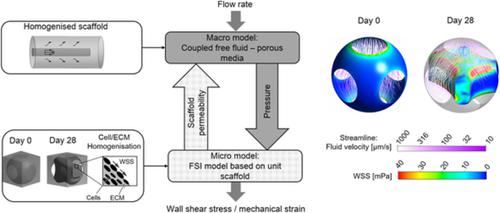当前位置:
X-MOL 学术
›
Int. J. Numer. Method. Biomed. Eng.
›
论文详情
Our official English website, www.x-mol.net, welcomes your feedback! (Note: you will need to create a separate account there.)
Fluid flow-induced cell stimulation in bone tissue engineering changes due to interstitial tissue formation in vitro.
International Journal for Numerical Methods in Biomedical Engineering ( IF 2.1 ) Pub Date : 2020-05-06 , DOI: 10.1002/cnm.3342 Feihu Zhao 1, 2, 3 , Bert van Rietbergen 1 , Keita Ito 1, 2 , Sandra Hofmann 1, 2
International Journal for Numerical Methods in Biomedical Engineering ( IF 2.1 ) Pub Date : 2020-05-06 , DOI: 10.1002/cnm.3342 Feihu Zhao 1, 2, 3 , Bert van Rietbergen 1 , Keita Ito 1, 2 , Sandra Hofmann 1, 2
Affiliation

|
In tissue engineering experiments in vitro, bioreactors have been used for applying wall shear stress (WSS) on cells to regulate cellular activities. To determine the loading conditions within bioreactors and to design tissue engineering products, in silico models are used. Previous in silico studies in bone tissue engineering (BTE) focused on quantifying the WSS on cells and the influence on appositional tissue growth. However, many BTE experiments also show interstitial tissue formation (i.e., tissue infiltrated in the pores rather than growing on the struts ‐ appositional growth), which has not been considered in previous in silico studies. We hereby used a multiscale fluid‐solid interaction model to quantify the WSS and mechanical strain on cells with interstitial tissue formation, taken from a reported BTE experiment. The WSS showed a high variation among different interstitial tissue morphologies. This is different to the situation under appositional tissue growth. It is found that a 35% filling of the pores results (by mineralised bone tissue) when the average WSS increases from 1.530 (day 0) to 5.735 mPa (day 28). Furthermore, the mechanical strain on cells caused by the fluid flow was extremely low (at the level of 10−14‐10−15), comparing to the threshold in a previous mechanobiological theory of osteogenesis (eg, 10−2). The output from this study offers a significant insight of the WSS changes during interstitial tissue growth under a constant perfusion flow rate in a BTE experiment. It has paved the way for optimising the local micro‐fluidic environment for interstitial tissue mineralisation.
中文翻译:

骨组织工程中流体流动诱导的细胞刺激由于间质组织的形成而在体外发生变化。
在体外组织工程实验中,生物反应器已用于在细胞上施加壁切应力(WSS)以调节细胞活性。为了确定生物反应器内的负载条件并设计组织工程产品,使用了计算机模型。先前在骨组织工程学(BTE)中进行的计算机模拟研究集中在量化细胞上的WSS及其对并位组织生长的影响。但是,许多BTE实验也显示出间质组织的形成(即组织渗透到毛孔中而不是在支柱的并列生长中生长),这在先前的计算机模拟研究中并未考虑。我们据此使用了多尺度的流固耦合模型来量化具有间质组织形成的细胞的WSS和机械应变,该模型取自已报道的BTE实验。WSS在不同的间质组织形态之间显示出很大的差异。这与并发组织生长的情况不同。已发现,当平均WSS从1.530(第0天)增加到5.735 mPa(第28天)时,孔隙的35%填充(由矿化的骨组织产生)导致。此外,由流体流动引起的对细胞的机械应变极低(在10级-14-10 -15),与先前的成骨力学生物学理论中的阈值相比(例如10 -2)。在BTE实验中,在恒定的灌注流速下,这项研究的结果提供了关于间质组织生长期间WSS变化的重要见解。它为优化组织间矿化的局部微流体环境铺平了道路。
更新日期:2020-05-06
中文翻译:

骨组织工程中流体流动诱导的细胞刺激由于间质组织的形成而在体外发生变化。
在体外组织工程实验中,生物反应器已用于在细胞上施加壁切应力(WSS)以调节细胞活性。为了确定生物反应器内的负载条件并设计组织工程产品,使用了计算机模型。先前在骨组织工程学(BTE)中进行的计算机模拟研究集中在量化细胞上的WSS及其对并位组织生长的影响。但是,许多BTE实验也显示出间质组织的形成(即组织渗透到毛孔中而不是在支柱的并列生长中生长),这在先前的计算机模拟研究中并未考虑。我们据此使用了多尺度的流固耦合模型来量化具有间质组织形成的细胞的WSS和机械应变,该模型取自已报道的BTE实验。WSS在不同的间质组织形态之间显示出很大的差异。这与并发组织生长的情况不同。已发现,当平均WSS从1.530(第0天)增加到5.735 mPa(第28天)时,孔隙的35%填充(由矿化的骨组织产生)导致。此外,由流体流动引起的对细胞的机械应变极低(在10级-14-10 -15),与先前的成骨力学生物学理论中的阈值相比(例如10 -2)。在BTE实验中,在恒定的灌注流速下,这项研究的结果提供了关于间质组织生长期间WSS变化的重要见解。它为优化组织间矿化的局部微流体环境铺平了道路。



























 京公网安备 11010802027423号
京公网安备 11010802027423号